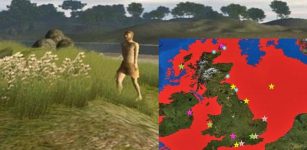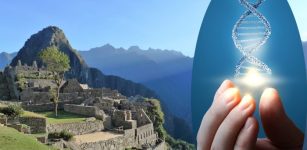Ancient Complex Of Elephanta Caves In India
A. Sutherland - AncientPages.com - The Elephanta Caves, believed to be dated to about the 7th century, represent a complex of ancient cave temples on Elephanta Island, located 10 km from the Gateway of India at Mumbai. These structures represent some of the most striking collections of rock-art in India.

Trimurti Sculpture - Elephanta Caves, India - The sculpture is 20 ft (6.1 m) high.; it is a colossal bust of the three forms of Shiva. Photo credits: ASI
The complex consists of two groups of caves—the first is a large group of five Hindu caves with rock-cut stone sculptures. The main cave is famous for its carvings depiciting the glorious Shiva, who is displayed in various forms and act ions. The cave consists of a square plan mandapa whose sides measure about 27 m.
The second (to the east) is a smaller group of two Buddhist caves with one of which is unfinished, and several cisterns.
The place - still worshipped by the locals - is dedicated to Lord Shiva.
The island, which covers an area of approximately 7 km, was initially called Gharapuri (literally "the city of caves"); later, the Portuguese renamed the island after they found a colossal stone elephant near their landing place.
Elephanta Island came under the dominion of at least half a dozen different powers that ruled this region from 400 BC to modern times.
Before the Hindu caves were excavated, the island was a Buddhist center. The remains of the Buddhist stupas in Elephanta probably date to the early phase of Buddhism (about the 2nd century BC.)
 Elephanta Caves, India - The island of Elephanta, the glorious abode of Lord Shiva and an epitome of Hindu cave culture, consists of seven caves on an island in the Sea of Oman close to Mumbai which, with their decorated temples and the images from Hindu mythology, bear a unique testimony to a civilization that has disappeared. Here, Indian art has found one of its most perfect expressions, particularly in the huge high reliefs in the main cave. Image source - Ministry of Culturen - Government of India
Elephanta Caves, India - The island of Elephanta, the glorious abode of Lord Shiva and an epitome of Hindu cave culture, consists of seven caves on an island in the Sea of Oman close to Mumbai which, with their decorated temples and the images from Hindu mythology, bear a unique testimony to a civilization that has disappeared. Here, Indian art has found one of its most perfect expressions, particularly in the huge high reliefs in the main cave. Image source - Ministry of Culturen - Government of India
The Buddhists, the first to carve temples from mountains, were followed by the Hindus. Every Hindu temple primarily worships one Hindu god, and the Elephanta Caves were for worshipping Shiva.
The statues carved on the walls of the Elephanta Caves are giant (about 20 feet high). They were elaborate, centering on a scene in Shiva's life featuring Shiva, his wife, and other influential personalities.
The date of the famous Elephanta Caves is still very much debated and varies from the 6th century to the 8th century according to the experts. There are many theories regarding the beginnings of the Elephanta Caves. Most of them propose that they were built from 450 to 750 AD.
Interestingly, this period also marks the decline of Buddhism in India and the revival of the Brahmanical traditions (ancient Indian religious traditions that have their beginnings in the early Vedic religion) in the country.

The Elephant statute from which Elephanta Island gets its name is now displayed in the Bhau Daji Lad Museum in Mumbai.
The most impressive of all the caves is Cave 1, which represents the evolved Brahmanical rock-cut architecture and displays several unique and lively sculptures.
The cave has a main entrance on the north with two other openings on the east and west, respectively, and a central hall with six rows (with six in each row) of pillared columns, six in each row except on the western corner, where a shrine contains a collection of rock art related to Shiva.
The temple dedicated to Lord Shiva is declared a UNESCO World Heritage Site.
Written by – A. Sutherland - AncientPages.com Senior Staff Writer
Updated on Oct 16, 2023
Copyright © AncientPages.com All rights reserved. This material may not be published, broadcast, rewritten or redistributed in whole or part without the express written permission of AncientPages.com
Expand for referencesMore From Ancient Pages
-
 Ice Age Cycles Played A Key Role In Early Human Interbreeding
DNA | Oct 19, 2023
Ice Age Cycles Played A Key Role In Early Human Interbreeding
DNA | Oct 19, 2023 -
 Qijia Culture – Its Disappearance Remains An Ancient Mystery
Civilizations | Feb 5, 2021
Qijia Culture – Its Disappearance Remains An Ancient Mystery
Civilizations | Feb 5, 2021 -
 DNA From Doggerland That Separates The UK From Europe – New Study
Archaeology | Jul 20, 2020
DNA From Doggerland That Separates The UK From Europe – New Study
Archaeology | Jul 20, 2020 -
 Ancient DNA Reveals A Diverse Community Lived At Machu Picchu, The ‘Lost City Of The Incas’
Archaeology | Jul 26, 2023
Ancient DNA Reveals A Diverse Community Lived At Machu Picchu, The ‘Lost City Of The Incas’
Archaeology | Jul 26, 2023 -
 Giants Of Monte Prama – Mysterious Ancient Statues With Unearthly Eyes
Artifacts | Aug 31, 2018
Giants Of Monte Prama – Mysterious Ancient Statues With Unearthly Eyes
Artifacts | Aug 31, 2018 -
 9,600-Year-Old Permament Settlement And Daily Tools Discovered In Turkey
Archaeology | Sep 2, 2022
9,600-Year-Old Permament Settlement And Daily Tools Discovered In Turkey
Archaeology | Sep 2, 2022 -
 Apkallu – Seven Antediluvian Sages Created By God Enki – Were They The Watchers?
Featured Stories | Mar 27, 2019
Apkallu – Seven Antediluvian Sages Created By God Enki – Were They The Watchers?
Featured Stories | Mar 27, 2019 -
 Evidence Of Neolithic Bird Hunting In Upper Mesopotamia
Archaeology | Sep 27, 2023
Evidence Of Neolithic Bird Hunting In Upper Mesopotamia
Archaeology | Sep 27, 2023 -
 Aboriginal Underwater Sites Off The Coast Of Australia – Discovered
Archaeology | Jul 2, 2020
Aboriginal Underwater Sites Off The Coast Of Australia – Discovered
Archaeology | Jul 2, 2020 -
 Secrets Of Ancient Skeletons Found In York – Who Were They And Where Did They Come From?
Archaeology | Jan 20, 2016
Secrets Of Ancient Skeletons Found In York – Who Were They And Where Did They Come From?
Archaeology | Jan 20, 2016 -
 Italian Sailors Knew Of America 150 Years Before Christopher Columbus – Ancient Documents Reveal
Archaeology | Oct 8, 2021
Italian Sailors Knew Of America 150 Years Before Christopher Columbus – Ancient Documents Reveal
Archaeology | Oct 8, 2021 -
 Moses’ Secret Knowledge Of Superior And Forbidden Technology – Alien Intervention And Events Erased From Historical Records – Part 2
Ancient Mysteries | Sep 24, 2020
Moses’ Secret Knowledge Of Superior And Forbidden Technology – Alien Intervention And Events Erased From Historical Records – Part 2
Ancient Mysteries | Sep 24, 2020 -
 Beautiful 2,300-Year-Old Gold Ring Found In The City Of David
Archaeology | May 30, 2024
Beautiful 2,300-Year-Old Gold Ring Found In The City Of David
Archaeology | May 30, 2024 -
 Anglo-Saxon Previously Unknown Monastic Or Trading Center – Discovered
Archaeology | Mar 7, 2016
Anglo-Saxon Previously Unknown Monastic Or Trading Center – Discovered
Archaeology | Mar 7, 2016 -
 Amage: Sarmatian Warrior Queen/Regent Who Impressed With Remarkable Military Skills
Featured Stories | May 23, 2023
Amage: Sarmatian Warrior Queen/Regent Who Impressed With Remarkable Military Skills
Featured Stories | May 23, 2023 -
 Social Tensions Among Ancient Pueblo Societies Contributed To Their Downfall – Not Only Drought
Archaeology | Apr 27, 2021
Social Tensions Among Ancient Pueblo Societies Contributed To Their Downfall – Not Only Drought
Archaeology | Apr 27, 2021 -
 Mysterious Pre-Celtic Civilization Who Came To Ireland From An Unknown Land
Featured Stories | Aug 13, 2024
Mysterious Pre-Celtic Civilization Who Came To Ireland From An Unknown Land
Featured Stories | Aug 13, 2024 -
 Ensisheim Meteorite Is The Oldest Meteorite With A Precise Date Of Impact
Ancient History Facts | Jun 29, 2018
Ensisheim Meteorite Is The Oldest Meteorite With A Precise Date Of Impact
Ancient History Facts | Jun 29, 2018 -
 On This Day In History: Practical Underwater Diving Suit Patented By Maine Inventor – On June 14, 1834
News | Jun 14, 2016
On This Day In History: Practical Underwater Diving Suit Patented By Maine Inventor – On June 14, 1834
News | Jun 14, 2016 -
 Wendigo: Cannibalistic Shapeshifter In Mythology Of Indians Of North America And Canada
Featured Stories | Sep 3, 2016
Wendigo: Cannibalistic Shapeshifter In Mythology Of Indians Of North America And Canada
Featured Stories | Sep 3, 2016
